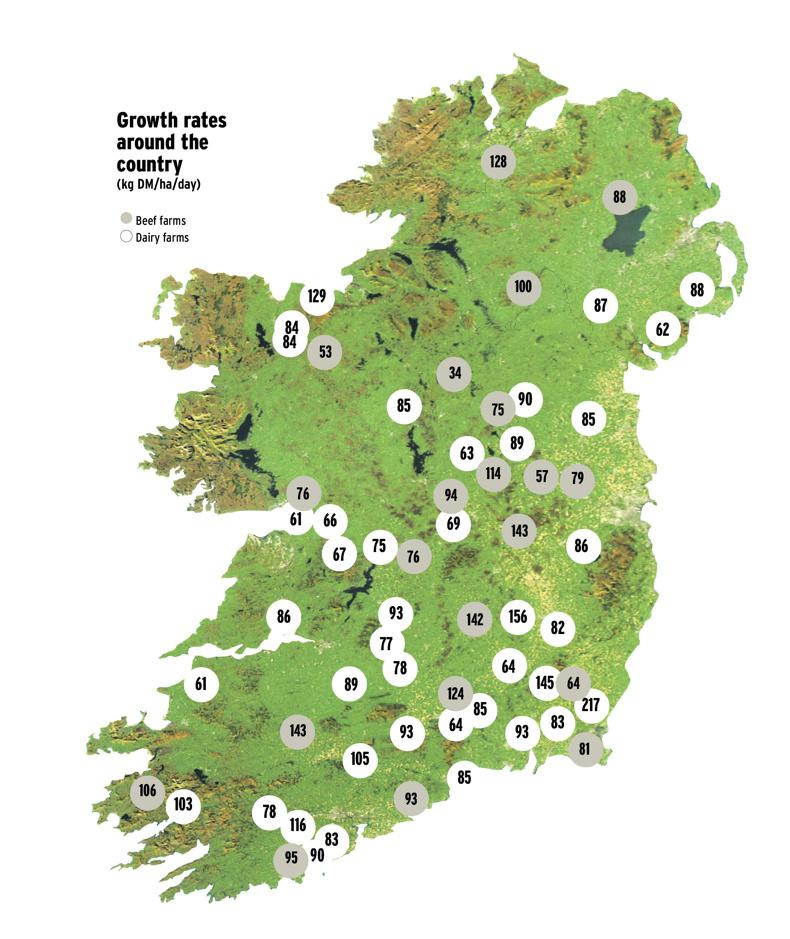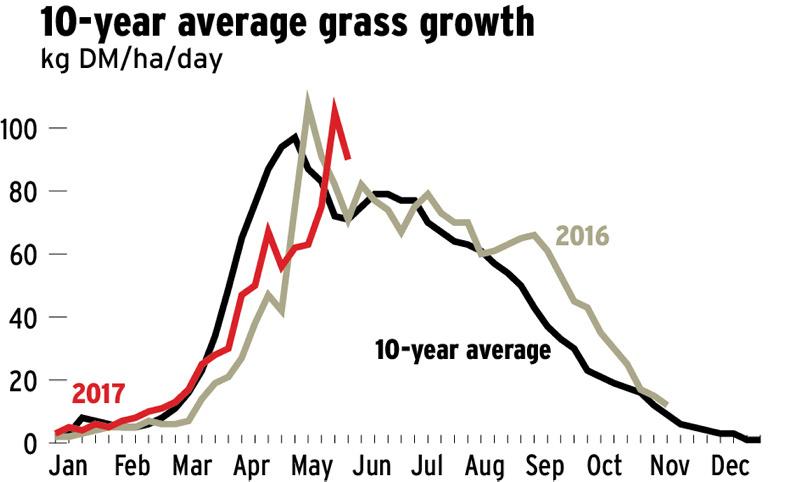Our measuring farms in the south have grown 91kg DM/ha/day in the last seven days, up from 85kg DM/ha/day last week. This is well up on the same week last year, when grass growth was suffering lack of moisture.
The fact that temperatures didn’t come back as much as was forecast and there was a decent degree of sunlight over the weekend kept growth rates higher than anticipated. At this point, surplus will be beginning to build again on most farms, with even highly stocked operations planning to go for more bales.
While intermittent heavy downpours in recent weeks have played havoc with silage making and grazing in some parts, rain volumes are forecast to be relatively low in the coming days. Indeed, the mercury is set to rise into the high teens over the weekend.
Use the opportunity to take out surplus bales before stemminess creeps into your swards. Stem in our swards means less energy going into our animals – stemmy grass has only 80% of the energy of leafy material. Energy intake is the biggest limiting factor affecting cattle performance.
Remember, animal performance on your beef farm is not simply the rate at which your bullocks or heifers are growing. Look at your cow herd currently in the middle of breeding. How much bulling activity are you seeing? Keeping leaf ahead of your cows will help to drive reproductive performance. The well-chronicled Newford Herd in Athenry is the perfect example of this. Herd manager Matthew Murphy is actively managing grassland here, having taken out 114 surplus round bales from grazing ground in May alone. The Newford cows are turning into pure leaf and moving on quickly. After three weeks of breeding, Matthew had served 92 out of 100 cows.

Grass growth 91kg DM/ha/day.Surplus building on most farms.Use dry conditions at weekend to remove bales if possible.Stemmy grass 20% less energy versus leaf.
Co Mayo
System suckler to bull beef
Soil type variable
Avg farm cover (kg DM/ha) 1542
Grass growth (kg DM/ha/day) 74
It’s been a super year so far for grass up here and growth is exceptional at the minute. I recorded a growth rate of 74kg DM/ha/day last week, over twice my daily demand, which is 34kg DM/ha/day. Grass is building quickly and I’m trying to keep on top of things by taking out paddocks and strip-grazing. The covers that I’m entering are bigger than I would like and at the next break in weather I will look at taking out more paddocks as bales. Though pre-grazing covers are high, paddocks are being well cleaned out, particularly by the cows on the home block. The bulls at grass are doing well and the heaviest of them will be housed later in August and finished. We carried out my farm plan recently and I hope to tighten up my calving pattern. A stock bull issue some years ago devastated my calving spread. Going forward I want to calve everything in autumn as I have the housing and it suits the under-16-month bull system, allowing me to get cheap weight on at grass.

Co Tipperary
System suckler to steer beef
Soil type variable
Avg farm cover (kg DM/ha) 939
Grass growth (kg DM/ha/day) 124
We harvested our first cut in the last week of May. Having grazed our silage ground before cutting for the first time this year, yield was slightly back but quality was very good.
We introduced reels and pig tails to divide paddocks this year also, and are finding we have more grass than ever with a higher stocking rate.
We will take out paddocks as bales once weather allows. This silage will be targeted for autumn cows and finishing steers. I had been following each grazing with two bags of 18-6-12 in an effort to build soil P and K. I am finding that I don’t need as much nitrogen with current stock levels, so may change to 10-10-20 to keep pushing soil fertility. Second-cut silage ground received two bags of 0-7-30 and parts got 2,000 gallons of slurry.
Our BETTER farm plan was laid out last week. Large targets lie ahead but having a plan on paper really focuses the mind.

Newford Herd
System suckler to beef
Soil type dry to heavy
Avg farm cover (kg DM/ha) 1034
Grass growth (kg DM/ha/day) 76
We are growing 76kg DM/ha/day – just surpassing our demand of 68kg DM/ha/day. We are stocked at 5LU/ha on the main block and have 15 days of grass ahead. In order to keep the absolute maximum quality in the sward, we will remove some more paddocks when the weather next allows.
During the month of May, 114 round bales were made from surplus grazing area alone. As of last weekend, all but one of the suckler herd had cycled. She was given a shot of prostaglandin (estrumate). Two stock bulls (LM and SI) were let in on Saturday 3 June and will work for four weeks mopping up any repeats.
Our replacement calves (26) are now on the contract-rearing farm in Tuam, grazing in a leader-follower system. Average weight is 115kg and they are growing at a rate of 0.73kg daily. They are receiving 1.5kg of an 18% crude protein concentrate at grass daily. All of their yearling counterparts have been submitted for AI at this point, which began on the 24 April. There have been no repeats to date.

Co Westmeath
System suckler to beef
Soil type mostly heavy
Avg farm cover (kg DM/ha) 712
Grass growth (kg DM/ha/day) 114
Grass is in reasonable supply on the farm. The recent rain has helped growth rates, but at this stage there is enough moisture in the ground and we could do with a dry spell.
The good growing conditions have allowed me to take out a number of surplus paddocks for bales. I have all my first-cut silage in and I was happy with the yield return. That ground has since received 3,000 gallons of slurry per acre and it will also get three bags of Cut Sward next week, with the aim being to take a second cut in July.
All stock are doing well at grass. Some of the stronger bulls will be taken in for finishing in the next couple of weeks.
The Charolais and Simmental stock bulls are out with the cows and there has been a lot of activity the last few weeks. I have had an easy-calving Angus bull running with my replacement heifers for the last few weeks and he will remain out for another month.

Read more
Grass+ dairy: exceptional grass growth rate continues
Our measuring farms in the south have grown 91kg DM/ha/day in the last seven days, up from 85kg DM/ha/day last week. This is well up on the same week last year, when grass growth was suffering lack of moisture.
The fact that temperatures didn’t come back as much as was forecast and there was a decent degree of sunlight over the weekend kept growth rates higher than anticipated. At this point, surplus will be beginning to build again on most farms, with even highly stocked operations planning to go for more bales.
While intermittent heavy downpours in recent weeks have played havoc with silage making and grazing in some parts, rain volumes are forecast to be relatively low in the coming days. Indeed, the mercury is set to rise into the high teens over the weekend.
Use the opportunity to take out surplus bales before stemminess creeps into your swards. Stem in our swards means less energy going into our animals – stemmy grass has only 80% of the energy of leafy material. Energy intake is the biggest limiting factor affecting cattle performance.
Remember, animal performance on your beef farm is not simply the rate at which your bullocks or heifers are growing. Look at your cow herd currently in the middle of breeding. How much bulling activity are you seeing? Keeping leaf ahead of your cows will help to drive reproductive performance. The well-chronicled Newford Herd in Athenry is the perfect example of this. Herd manager Matthew Murphy is actively managing grassland here, having taken out 114 surplus round bales from grazing ground in May alone. The Newford cows are turning into pure leaf and moving on quickly. After three weeks of breeding, Matthew had served 92 out of 100 cows.

Grass growth 91kg DM/ha/day.Surplus building on most farms.Use dry conditions at weekend to remove bales if possible.Stemmy grass 20% less energy versus leaf.
Co Mayo
System suckler to bull beef
Soil type variable
Avg farm cover (kg DM/ha) 1542
Grass growth (kg DM/ha/day) 74
It’s been a super year so far for grass up here and growth is exceptional at the minute. I recorded a growth rate of 74kg DM/ha/day last week, over twice my daily demand, which is 34kg DM/ha/day. Grass is building quickly and I’m trying to keep on top of things by taking out paddocks and strip-grazing. The covers that I’m entering are bigger than I would like and at the next break in weather I will look at taking out more paddocks as bales. Though pre-grazing covers are high, paddocks are being well cleaned out, particularly by the cows on the home block. The bulls at grass are doing well and the heaviest of them will be housed later in August and finished. We carried out my farm plan recently and I hope to tighten up my calving pattern. A stock bull issue some years ago devastated my calving spread. Going forward I want to calve everything in autumn as I have the housing and it suits the under-16-month bull system, allowing me to get cheap weight on at grass.

Co Tipperary
System suckler to steer beef
Soil type variable
Avg farm cover (kg DM/ha) 939
Grass growth (kg DM/ha/day) 124
We harvested our first cut in the last week of May. Having grazed our silage ground before cutting for the first time this year, yield was slightly back but quality was very good.
We introduced reels and pig tails to divide paddocks this year also, and are finding we have more grass than ever with a higher stocking rate.
We will take out paddocks as bales once weather allows. This silage will be targeted for autumn cows and finishing steers. I had been following each grazing with two bags of 18-6-12 in an effort to build soil P and K. I am finding that I don’t need as much nitrogen with current stock levels, so may change to 10-10-20 to keep pushing soil fertility. Second-cut silage ground received two bags of 0-7-30 and parts got 2,000 gallons of slurry.
Our BETTER farm plan was laid out last week. Large targets lie ahead but having a plan on paper really focuses the mind.

Newford Herd
System suckler to beef
Soil type dry to heavy
Avg farm cover (kg DM/ha) 1034
Grass growth (kg DM/ha/day) 76
We are growing 76kg DM/ha/day – just surpassing our demand of 68kg DM/ha/day. We are stocked at 5LU/ha on the main block and have 15 days of grass ahead. In order to keep the absolute maximum quality in the sward, we will remove some more paddocks when the weather next allows.
During the month of May, 114 round bales were made from surplus grazing area alone. As of last weekend, all but one of the suckler herd had cycled. She was given a shot of prostaglandin (estrumate). Two stock bulls (LM and SI) were let in on Saturday 3 June and will work for four weeks mopping up any repeats.
Our replacement calves (26) are now on the contract-rearing farm in Tuam, grazing in a leader-follower system. Average weight is 115kg and they are growing at a rate of 0.73kg daily. They are receiving 1.5kg of an 18% crude protein concentrate at grass daily. All of their yearling counterparts have been submitted for AI at this point, which began on the 24 April. There have been no repeats to date.

Co Westmeath
System suckler to beef
Soil type mostly heavy
Avg farm cover (kg DM/ha) 712
Grass growth (kg DM/ha/day) 114
Grass is in reasonable supply on the farm. The recent rain has helped growth rates, but at this stage there is enough moisture in the ground and we could do with a dry spell.
The good growing conditions have allowed me to take out a number of surplus paddocks for bales. I have all my first-cut silage in and I was happy with the yield return. That ground has since received 3,000 gallons of slurry per acre and it will also get three bags of Cut Sward next week, with the aim being to take a second cut in July.
All stock are doing well at grass. Some of the stronger bulls will be taken in for finishing in the next couple of weeks.
The Charolais and Simmental stock bulls are out with the cows and there has been a lot of activity the last few weeks. I have had an easy-calving Angus bull running with my replacement heifers for the last few weeks and he will remain out for another month.

Read more
Grass+ dairy: exceptional grass growth rate continues












 This is a subscriber-only article
This is a subscriber-only article
















SHARING OPTIONS: